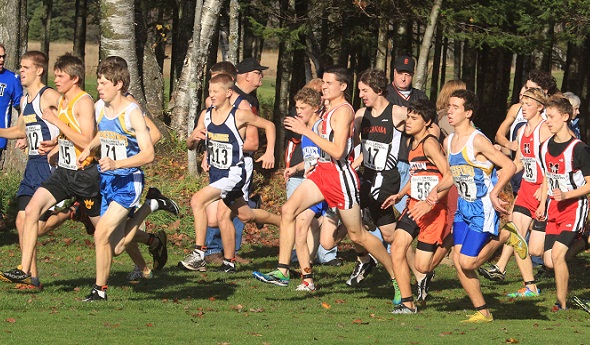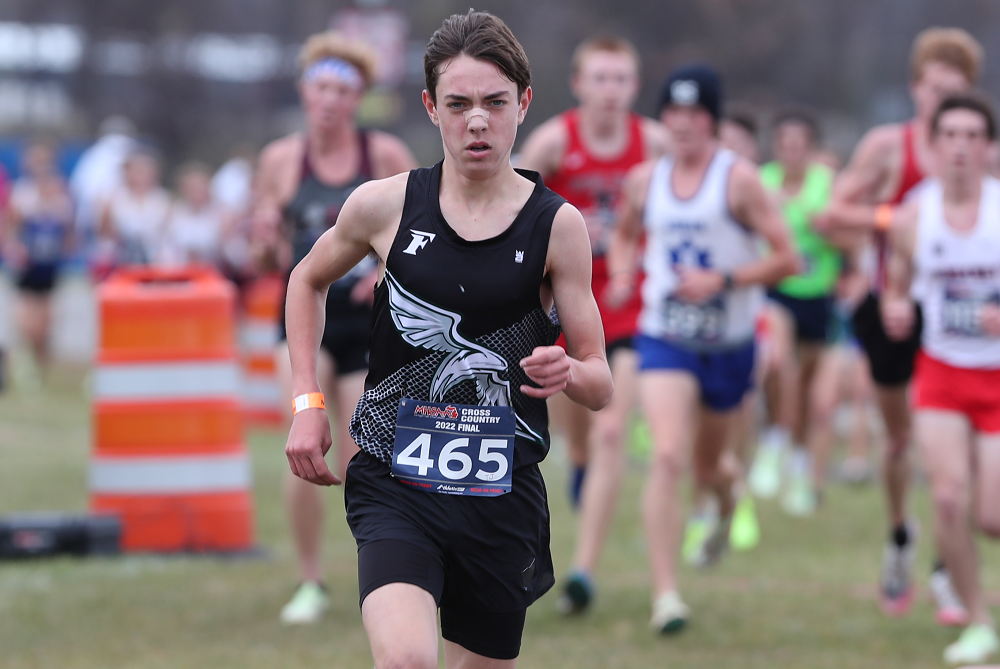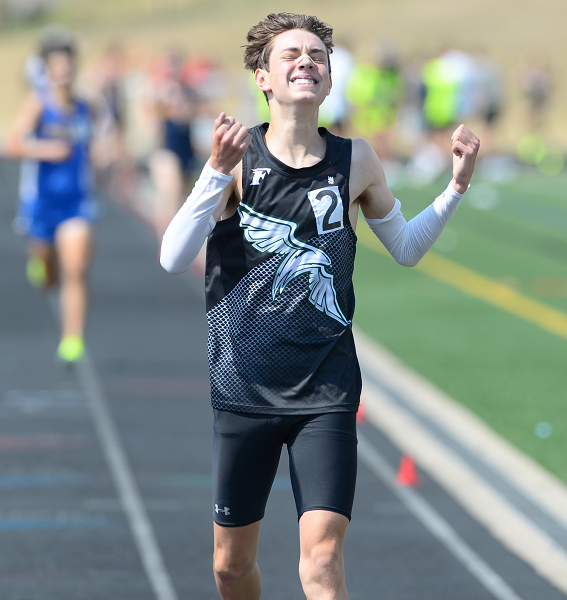
Freshman leads Sault Ste. Marie to Win
By
John Vrancic
Special for MHSAA.com
October 20, 2012
MUNISING — Sault Ste. Marie freshman Parker Scott had been setting school records quite regularly throughout this cross country season.
Although his 16-minute, 50.5-second clocking on the 3.1-mile course at Pictured Rocks Golf & Country Club during Saturday’s Upper Peninsula Cross Country Finals wasn’t a school record, it was good enough to earn the Division 1 title.
“The weather was great, but the course was a little wet” said Scott, this year’s Straits Conference champ who also won the Rudyard Invitational in a school-record 16:12 on Oct. 13. “The slippery footing slowed everyone down. I felt good in the beginning, then I tweaked my hip and it disrupted my rhythm. Although, I think it will be all right. I’m good at adapting to changes. It really didn’t affect me that much.”
The victory enabled Scott to finish this season undefeated.
“Winning any race is awesome,” said Scott, who also won on the Pictured Rocks course in 16:15 on Sept. 25. “The win at Rudyard was definitely a good achievement. That course is flat and fast, similar to this one.”
Scott’s effort also helped the Blue Devils gain their first U.P. title in 11 years with 65 points. Runner-up Escanaba scored 72 and Kingsford took third with 101.
Kingsford senior Dan Kulas took second (16:58.6), edging Houghton sophomore Jacob Colling by a step on this sunny and seasonably cool day.
“I really wanted to at least get runner-up,” said Kulas, who’s considering going out for cross country at Michigan Tech next year. “Parker is a great runner. I’m pleased I could stay that close (within 8.1 seconds) to him. There were lot of potholes and they slowed us up a little. The footing wasn’t the best (due to the recent rainfall).”
Kulas became two-time Great Northern Conference champ on Oct. 11, and Colling was crowned West-Pac Conference champion for the first time on the same day.
“Dan and I were going at it the last quarter-mile,” Colling said. “I was kind of shooting for the top three or top five, somewhere in that range. It was close. This was a real good race for me. I’m very excited about what I did here today. This is a great way to end the season. All the potholes made it a little interesting, but we had beautiful weather. I think running in the first race today may have been a good thing because the course probably got more chewed up as the day went on.”
Division 2
Stephenson captured its third consecutive Division 2 title with 52 points, followed by Norway with 67 and Hancock’s 76.
The Eagles were led by sophomore Connor Cappaert, who gained his first U.P. championship in 17:25.7. He was followed by Ironwood sophomore Jared Joki (17:43.4) and Manistique senior and Tyler Pomeroy (18:13.2). Joki was crowned Indianhead Conference champion last week and Pomeroy was two-time Mid-Peninsula Conference champ.
“Winning here was definitely a goal,” said Cappaert. “It was a dream come true. I’m also so happy our team came away as U.P. champion. All of our runners gave it their all today. Goals were set for all of us and we met those. We peaked at the best time possible. This has been a fun year for us.”
Division 3
Munising retained its Division 3 title with 55 points, followed by Cedarville with 72 and St. Ignace with 90.
Freshman Brett Hannah won on his home course in 17:55, followed by Cedarville’s Josh Hester (18:00.3) and Munising’s Izaak Mahoski (18:00.8).
“I’m pretty happy to win it here with all the hometown support,” said Hannah, who also earned the Central U.P./Skyline Conference title on Oct. 10. “We ran this course a couple times this year and were comfortable with it. We knew there were quite a few potholes, and we knew where they were at. I’m glad I could contribute to us keeping the trophy at home. I think this gives us a little confidence going into next year.”
Sophomore Zack Mazurek became the first Bessemer athlete to medal in the U.P. Cross Country Finals, placing fourth in Division 3 (18:09.2).
“It took me a little while to learn the pacing and where I needed to be,” Mazurek said. “I ran against some of these guys in my freshman year (in track) and felt I could be in contention. But I think their experience probably paid off in the end.”
PHOTO: Runners work to lead a pack at the Division 1 race at Saturday's Upper Peninsula Finals at Munising (Photo courtesy of RunMichigan.com/Paul Gerard).

Freeland's Hansen Not Focused on Joining All-Time Greats - But On His Way
By
Paul Costanzo
Special for MHSAA.com
September 29, 2023
The goal written on Matt Kaczor’s Post-It Note was sub-15 minutes, 15 seconds. That’s what the Freeland cross country coach was hoping for from star runner TJ Hansen during his junior season.
 Kaczor tore it up after seeing Hansen run a single race this fall.
Kaczor tore it up after seeing Hansen run a single race this fall.
“Knowing what he did over the summer and where he was at, seeing what his 1,600 (meter) and his mile got down to, I had a feeling he could get under 15:30 quickly,” Kaczor said. “After the first race, I looked at my assistant and was like, ‘I’ve gotta rip up that Post-It Note. I don’t think our goal is on the level of where he’s at right now.’ At first, it was break 15:15. Once I saw him race at the Under the Lights (on Aug. 18 at St. Johns), I was like, ‘Yeah, he’s going sub 15.’”
Hansen ran 15:39.6 in that first race, and on Sept. 7, in Shepherd, he ran 15:13.9 to meet the goal written on the now-shredded Post-It Note.
This past Saturday, he ran 15:03.7 at the Cadillac Veterans Serving Veterans Invitational. It’s the fastest time recorded in Michigan this year, and a signal that Kaczor might be filling out a new Post-It Note before the season is out.
“The sub-15 barrier, that’s been something on my mind for a while,” Hansen said. “Now that I’m edging closer and closer to that, it’s been exciting. With how heavy my training has been, I wouldn’t expect (to have run this fast this early). Being able to run the times I am really paints the picture for what’s ahead.”
Hansen came into the season already regarded as one of the elite distance runners in the state. He won the 3,200 meters at the MHSAA Lower Peninsula Division 2 Track & Field Finals this past spring. He’s also finished all-state (12th and fifth, respectively) the past two seasons at the LPD2 Cross Country Finals.
His current trajectory, however, would put his name near some of the state’s all-time greats. But that’s not something Hansen is focusing on.
“I really don’t like to compare myself to others,” he said. “I don’t focus on that. I try to be the best TJ Hansen that I can be. The best version of myself.”
Focusing on himself is almost necessary for Hansen, as he’s spending a lot of time during his races running by himself.
At each of the big events Freeland has run in this season, Hansen has finished at least 20 seconds ahead of his nearest competitor. That includes all divisions of the Duane Raffin Festival of Races in Holly.
In Cadillac, where Hansen ran his current best time, he was a full minute ahead of the rest of the field.
 “He’s just a special athlete,” Kaczor said. “I can’t see Freeland having someone like this in a while. He’s a generational talent. What’s crazy is, I had the school record when he was a freshman. He and Braden (Honsinger) broke it last year. But TJ has now dropped that school record (set in 1998) by almost a minute.”
“He’s just a special athlete,” Kaczor said. “I can’t see Freeland having someone like this in a while. He’s a generational talent. What’s crazy is, I had the school record when he was a freshman. He and Braden (Honsinger) broke it last year. But TJ has now dropped that school record (set in 1998) by almost a minute.”
Hansen’s achievements have already put him on a path to run at the next level, which is something of a family tradition.
His older sisters Peyton and Kiera are track & field athletes at Wayne State and Eastern Michigan, respectively. Their parents, Tim and Pam, were track & field stars at Central Michigan.
TJ has drawn the attention of coaches around the country, including from Michigan, Michigan State, Wisconsin, Tennessee and Colorado.
Having family members who know the process is a help for Hansen, and he said they’ve all been good about allowing him to choose his own path, whatever that may be.
“He’s from a good family that knows how to work and knows how to get things done,” Kaczor said. “He knows that if he puts in the work, he’s going to be at a good spot.”
While Hansen admits it can be a bit overwhelming, he’s using it as motivation to run faster and continue to put his name out there.
Also serving as motivation is 2022 Division 2 champion Connell Alford of Chelsea. Alford is among the elite group of runners in Michigan who have broken the 15-minute mark, doing it twice a year ago.
He currently has the state’s second-best time behind Hansen’s this year, running 15:09.1 at the MSU Invitational on Sept. 15.
“Whenever I see him drop a time, my main goal is to run faster,” Hansen said. “Whenever I see him run a good time, that motivates me to work hard.”
The two won’t see each other until the MHSAA Finals on Nov. 4 at Michigan International Speedway. It’s an opportunity Hansen is excited for, as it’s a chance to race and be pushed toward the lofty goals he’s set for himself. Kaczor is excited about it, too, even if it might mean having to replenish his supply of Post-Its.
“We don’t talk about winning the state title; we talk about making sure that we have great races on those days,” Kaczor said. “We can’t control how somebody else runs. It’s a matter of can we, if the weather is right and the course is in good condition, can we be one of the few guys that has run in the 14s on that course? That’s the goal. Put yourself in some great categories with those upper echelons and the greats of all-time.”
 Paul Costanzo served as a sportswriter at The Port Huron Times Herald from 2006-15, including three years as lead sportswriter, and prior to that as sports editor at the Hillsdale Daily News from 2005-06. He can be reached at [email protected] with story ideas for Genesee, Lapeer, St. Clair, Sanilac, Huron, Tuscola, Saginaw, Bay, Arenac, Midland and Gladwin counties.
Paul Costanzo served as a sportswriter at The Port Huron Times Herald from 2006-15, including three years as lead sportswriter, and prior to that as sports editor at the Hillsdale Daily News from 2005-06. He can be reached at [email protected] with story ideas for Genesee, Lapeer, St. Clair, Sanilac, Huron, Tuscola, Saginaw, Bay, Arenac, Midland and Gladwin counties.
PHOTOS (Top) Freeland's TJ Hansen leads a pack during last season's LPD2 Final at Michigan International Speedway. (Middle) Hansen enjoys a moment of exhilaration after winning the 3,200 this spring at the LPD2 Finals at Ada Forest Hills Eastern. (Top photo by Carter Sherline/Run Michigan; middle photo by Dave McCauley/Run Michigan.)

